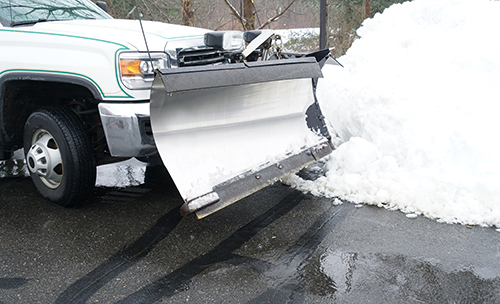 In Colorado, no single commercial property operating expense has the ability to blow up a budget faster than snow removal. Forecasting for snow removal is at best, a shot in the dark; historical averages and previous year totals don’t seem matter much to Mother Nature when budgeting for snow (and ice) removal. And, most of the time it’s the tenants who bear the burden of these costs through triple-net leases. But the implications of snow events go far beyond the budget; increased inclement weather also means increased exposure to liability due to slip-and-fall events. A well-conceived snow and ice removal protocol, in addition to realistic budgeting, can help protect the property owner’s assets.
In Colorado, no single commercial property operating expense has the ability to blow up a budget faster than snow removal. Forecasting for snow removal is at best, a shot in the dark; historical averages and previous year totals don’t seem matter much to Mother Nature when budgeting for snow (and ice) removal. And, most of the time it’s the tenants who bear the burden of these costs through triple-net leases. But the implications of snow events go far beyond the budget; increased inclement weather also means increased exposure to liability due to slip-and-fall events. A well-conceived snow and ice removal protocol, in addition to realistic budgeting, can help protect the property owner’s assets.
Tenant Communication is Key
Many properties we manage had their snow removal expenses double over the previous year; in some cases, they tripled. While there’s not much a manager or owner can do to mitigate the costs of snow removal, it’s beneficial to be communicative with tenants regarding these expenses. A simple note of explanation when sending CAM reconciliations and budgets can go a long way in terms of tenant relations. While tenants often have difficulty understanding increased expenses such as insurance or tax costs, snowstorms are hard to argue against.
Forecasting Snow Removal Expenses
The 2018-2019 snow season for Metro Denver was one of the worst in recent memory. In fact, the Denver 2018-2019 snow total of 48 inches was larger than the previous two years combined. However, this was still below the long-term average of 57 inches. Denver determines its official totals by snowfall at the airport; however, snow totals vary greatly across the Metro Area. During the same snow season, Lakewood had 57 inches, Wheat Ridge 64 inches, and Boulder’s total was 90 inches. Given these variations, how do you budget for snow and ice removal effectively?
Probably the easiest way to forecast snow removal expenses is to use historical averages of snowfall and corresponding costs. This will rarely be accurate, but realistically it is the best predictor available. In addition, recent changes in snow vendor liability limitations should cause a property manager or owner to give careful consideration to this budget line item. Owners should not only estimate the expense, but fully understand the service contract, the expected service levels, and the documentation that should be produced for each snow/service event.
New Legislations on Snow Removal Service Liability
In May 2018, Governor Hickenlooper signed into law the “Snow Removal Service Liability Limitation Act“. This law mimicked similar laws from other states, with the goal of ensuring that liability is more properly assigned to the party at fault. Owners and managers who view blanket indemnity provisions as a means of protecting themselves may find they are no longer able to shift risk in this manner. The underlying sentiment was that real estate owners are usually more adept at contract matters, and have better legal resources than do small snow-removal providers, and therefore owners would insert blanket indemnity, ‘hold harmless’, and ‘defend against’ clauses that are much more protective of the landlord.
Specifically, the following types of provisions are no longer enforceable in Colorado:
- An agreement by a service provider (snow removal contractor) to indemnify a service receiver (typically a property owner or property management company) from the service receiver’s own acts or omissions.
- An agreement by a service receiver to indemnify a service provider from the service provider’s own acts or omissions.
- An agreement by a service provider to hold harmless a service receiver from any tort claim arising from the service receiver’s own acts or omissions.
- An agreement by a service receiver to hold harmless a service provider from any tort claim arising from the service provider’s own acts or omissions.
- An agreement by a service provider to defend a service receiver from any tort claim arising from the service receiver’s own acts or omissions.
- An agreement by a service receiver to defend a service provider from any tort claim arising from the service provider’s own acts or omissions.
In short, it’s more difficult for landlords or snow removal contractors to use contractual clauses as a shield against liability.
“Social Inflation” Trends on the Rise
To make matters worse, there is the trend known in the insurance industry as “social inflation”. This refers to an upward creep in perception by an injured party of what they are owed, and their willingness to pursue that via the legal system. In other words, people are more litigious, and expect higher payouts. In recent settlements for slip-and-fall cases, there was a $4 million jury award against an HOA for a parking lot slip-and-fall, and a $2.2 million award against a self-storage business.
This past year, we received a notice of a lawsuit for a slip-and-fall incident at one of our commercial properties. With no prior knowledge of the incident, we received the documents 11 days before the expiration of the two-year statute of limitations. As is often the case with these types of claims, they are filed at the last minute in the hope that memories are faded, documentation lost, or relevant managers or employees are no longer working for the owner, property manager, or snow removal company.
With that in mind, owners and property managers must be diligent in spelling out the expected services and keeping excellent documentation for each snow or ice event.
Mitigation Tasks and Best Practices
What best practices can a landlord or property manager implement to keep their tenants safe and also protect against lawsuits? Having a plan of when to act, who should act, and ensuring their completion and documentation, is key.
Trigger depth refers to the the level of snowfall at which removal protocols begin. Most commercial properties have a trigger depth of two inches, while many retail properties trigger at one inch. Ice events occur when rain or fog freezes, or when the temperature drops after a light warm snow. Such cases may not meet the 1-2” threshold, but the conditions can still be treacherous. These instances can be especially problematic for those relying on snow removal contractors as they will not have been ‘activated’ to do work – and yet the risk is high.
An outside vendor, in-house staff, or a combination of the two can perform snow and ice removal. No matter who performs the work, the owner or property manager must ensure the tasks are completed, and documented. Storms affect an entire region, so the busy snow removal companies can’t be at every property at the same time. Don’t assume that because you signed a contract the snow removal service will be there exactly when you need them. During events it’s important to confirm that someone is actually doing the work. Staff or owners themselves may need to go on-site to make sure the most important walkways are being cleared; keep adequate equipment and de-icer at the building so that anyone can perform the work.
Document Events with a Snow Log
It’s imperative that the property has a well-maintained snow log that records every instance of snow removal or de-icing activity. This is the first line of defense against claims. The log must be easily accessible and a responsible party must fill it out during every event. Don’t just rely on a snow-removal company employee to complete the log; it’s incumbent on the owner or the landlord to ensure that everything has been documented correctly. Remove the physical logs from the building each season and store them for future access (weeks or years).
Planning for the Unpredictable
Snow and ice storms are always a headache operationally and financially; they are unpredictable and unavoidable. In terms of budgeting, the best an owner can do is use historical averages to estimate the annual costs. However, a well-conceived snow and ice removal plan, one that ensures that the necessary functions are being performed thoroughly and in a timely manner, no matter how significant the weather event, can help protect the landlord against significant and time-consuming costs in the future.
 Brian Lantzy is the Vice President of Operations at Wheelhouse Commercial in Denver, Colorado. For more information about how Wheelhouse Commercial can help manage your properties, please call 303.518.7406 or email info@wheelhousecommercial.com.
Brian Lantzy is the Vice President of Operations at Wheelhouse Commercial in Denver, Colorado. For more information about how Wheelhouse Commercial can help manage your properties, please call 303.518.7406 or email info@wheelhousecommercial.com.

